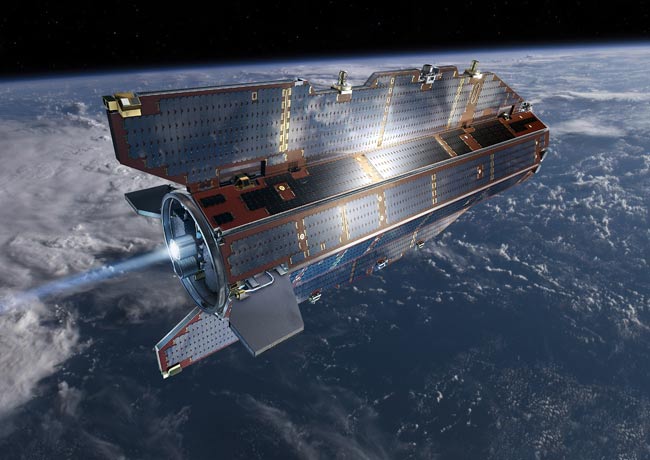Gravity-Mapping Satellite's Communications Glitch to Be Fixed Soon

PARIS? Ground controllers are graduallyraising the orbit of Europe's GOCE gravity-measuring satellite inpreparationfor a series of procedures they hope will permit the satellite torecover itsdata-transmission function, which failed in July.
Theprocedures, designed by a team ofengineers from the European Space Agency (ESA) and GOCE's industrialcontractors, had not been approved for use as of Aug. 24. But Mark R.Drinkwater, head of ESA's Earth observation mission science division,said somevariant of the proposed data-restoration plan would be approved, andthat bymid-September, GOCEcontrollersshould have an ideaof whether the plan is working.
GOCE,or the Gravity and steady-state OceanCirculation Explorer, was launchedin March2009 on a two-yearmission. It has produced its first global maps of the minor differencesin gravitationalattractionof different parts of the Earth. ESA officials say GOCE is the firstsatelliteto produce such maps.
Thesatellite has already performedtwo-thirds of its mission assignments. Its managers nonetheless hadhoped to continuethe mission beyond 2011 given the fact that the relatively low solaractivityin the past year has permitted GOCE to fly at an exceptionally loworbit anduse relatively little fuel to eliminate the atmospheric drag thatinhibitsflight at GOCE's 256-kilometer operating altitude.
"Wehave four of a planned six mappingscompleted, and we have fuel in the bank," Drinkwater said in an Aug. 24interview. "There is no reason we couldn't operate until the end of2012,if our member states grant us approval."
GOCE'smain computer failed in February inwhat mission managers describe as a rare and still-unexplained failureof acomputer chip that has flown many times on satellite missions.
Withthe main computer out of service, theJuly failure prevented GOCE from sending science data altogether. Aboard ofinquiry has been established to examine the July incident, butDrinkwater saidit is already clear that it bears no relation to the February computerchipfailure.
Get the Space.com Newsletter
Breaking space news, the latest updates on rocket launches, skywatching events and more!
"Thepresent anomaly manifests itself ina different manner from the previous problem, as the processor itselfremainshealthy," ESA said in a statement on the GOCE telemetry issue.
Itremains unclear exactly what componentsuffered the glitch that stopped the flow of science data. The18-nation ESA,in July 22 and Aug. 3 statements about GOCE's status, said the problemappearsto reside either in the backup computer's processor board or in thesatellite'stelemetry module. Several attempts to reboot the backup computer havenotovercome the data-transmission problem.
Theproposed work-around includes returningGOCE's nominal computer to partial service, and combining that capacitywithsimilar capacity available on the backup computer despite the Julyglitch.
Drinkwatersaid GOCE continues to respond tocommands and shows no sign of having lost any of its data-generatingability.
Groundteams have sent software commands toGOCE that have forced the satellite to deliver more telemetry than itnormallydoes, enabling controllers to verify the status of all the satellite'ssystemsin preparation for the recovery operation.
Aspart of that preparation, GOCE's orbit isbeing raised by about 9 kilometers, to 265 kilometers, in anticipationof thefact that during the recovery, it may lose the use of its xenon-ionelectricpropulsion system, which permits GOCE to compensate for atmosphericdrag as itflies. Also helping the satellite fly is its peculiar aerodynamicdesign,resembling an arrowhead.
Thetemporary loss of the propulsion systemwould cause GOCE to lose altitude almost immediately.
Manyof its components have never flownbefore, including its gradiometer payload, composed of three pairs ofaccelerometers that will produce a globalmap of gravity'sdiffering pullin different regions of Earth, which were built by France's Oneraaerospaceresearch institute, and its xenon-ion thrusters, built by Qinetiq ofBritain.But it is not these systems that have caused GOCE's problems so far.
- IsThere Gravity In Space?
- Top10 Strangest Things in Space
- Video? Europe's GOCE: Formula One of Satellites
This article was provided bySpace News,dedicated to covering all aspects of the space industry.
Join our Space Forums to keep talking space on the latest missions, night sky and more! And if you have a news tip, correction or comment, let us know at: community@space.com.
Peter B. de Selding is the co-founder and chief editor of SpaceIntelReport.com, a website dedicated to the latest space industry news and developments that launched in 2017. Prior to founding SpaceIntelReport, Peter spent 26 years as the Paris bureau chief for SpaceNews, an industry publication. At SpaceNews, Peter covered the commercial satellite, launch and international space market. He continues that work at SpaceIntelReport. You can follow Peter's latest project on Twitter at @pbdes.









